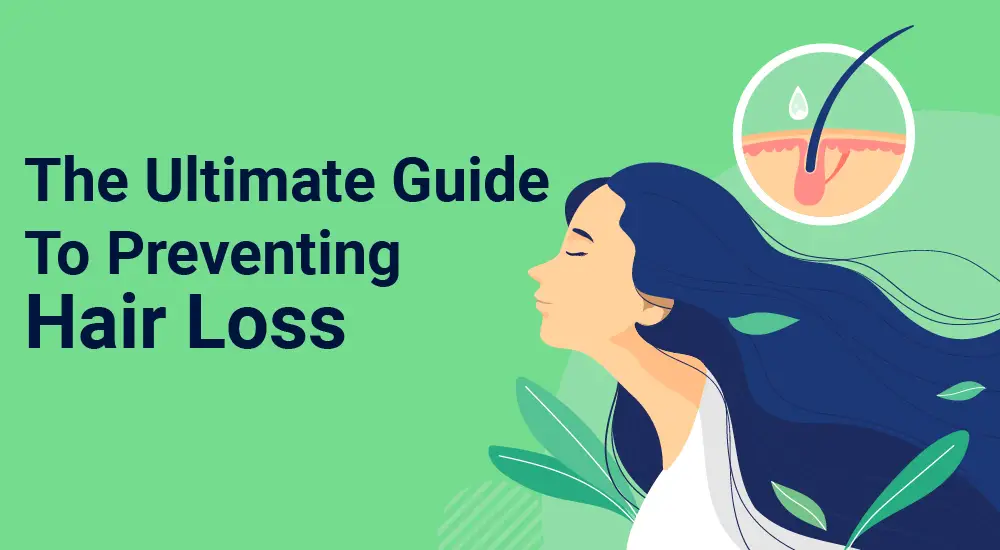
Have you noticed that you’re starting to lose some of your hair? If you have, then it’s essential to address the issue straight away. This isn’t just for your hair’s health, but for your mental health, too.
One of the biggest issues people suffering from hair loss have to face is the aesthetic aspect.
If you’ve been sporting a full head of hair for a while and are suddenly noticing bald or thinning patches, it can be extremely difficult to adjust to this.
There’s more than just an aesthetic issue with hair loss, though. After all, many people look fantastic rocking a bald head.
For some people, it can completely destroy their confidence and it can take a very long time to start feeling like the “old you” again.
If you’re beginning to notice the signs of hair loss and are feeling as though you want to stop it in its tracks, you’ve come to the right place. Below, you’ll find the ultimate guide to preventing hair loss.
Throughout this guide, we’ll look at what causes hair loss, some of the different signs, and, most importantly, how to prevent it.
Table of Contents
What Is Hair Loss?

The term ‘hair loss’ is fairly self-explanatory, but it’s something that can happen in a variety of ways. You might notice hair loss from just your scalp, or from your entire body.
It doesn’t mean total baldness either, as hair loss can present itself as thinning hair or patches of baldness.
Although hair loss is more common in men, it isn’t something that is exclusive to certain sexes or age groups.
Both men and women of all ages may find that their hair has started to fall out. In fact, approximately 35 million men and 21 million women suffer from hair loss.
Most men within this group notice a 40% loss rate at the age of 35, increasing to a 70% loss rate by the age of 80. While women who suffer from hair loss will notice an 80% loss rate by the age of 60.
Why Do People Lose Their Hair?
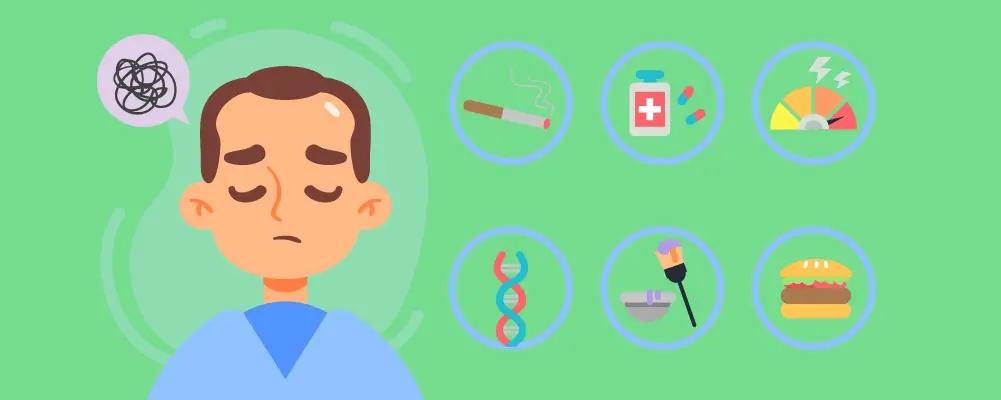
Finding out what’s causing your hair loss is the first step in preventing further loss from happening. Below, we’ll take a look at some of the biggest causes of hair loss to help you identify the issue and make changes wherever possible.
While it’s perfectly normal to shed anywhere between 50 and 100 hairs a day, anything more than this can be considered a sign of hair loss and should be treated swiftly.
Hereditary Reasons

One of the most common causes of hair loss is a hereditary condition that comes with aging.
Known as male-pattern and female-pattern baldness, or by its more scientific name of androgenic alopecia, this type of hair loss happens gradually over time.
It also occurs in quite a predictable way, presenting itself in the form of receding hairlines and bald spots for men, and thinning along the crown of the scalp in women.
You might be concerned that since this hair loss cause is genetic, it’s not something that you’re able to escape from.
However, there are certain things you can do to help prevent it from taking too much of a toll on your hair, and we’ll look into these a little later.
Illnesses
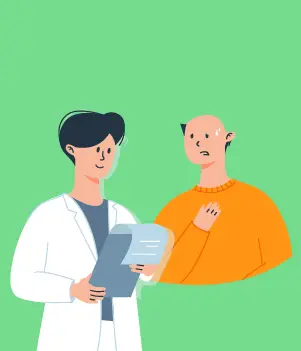
Certain illnesses can trigger a type of temporary hair loss called telogen effluvium.
This causes the rate of hair loss to increase, but it does not cause a person to lose all of their hair.
Instead, the hair becomes noticeably thinner and, once the illness has passed, the hair will start to regrow normally.
Other causes of telogen effluvium include pregnancy, childbirth, and you may also suffer from this type of hair loss if you’re recovering from particularly invasive surgery.
Basically, anything that puts your body into some sort of shock can result in temporary hair loss.
Stress
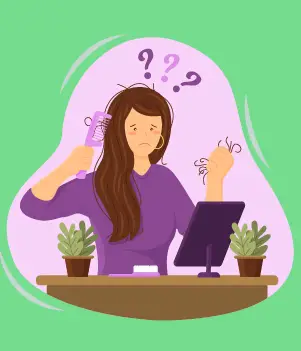
Another reason why somebody may suffer from hair loss is excess stress.
This can be continual, day-to-day stress, or physical and emotional shock.
Telogen effluvium and alopecia areata are the most common forms of hair loss associated with stress, and it usually presents itself as a temporary thinning of hair or temporary bald patches.
Cancer Treatment
If you’ve been diagnosed with cancer and you’re undergoing chemotherapy or radiotherapy, your hair will fall out as a result of the treatment.
Your hair will grow back once you’ve completed your course of treatment, but it doesn’t happen immediately.
This is because it takes a while for the chemotherapy drugs to completely leave your system and stop attacking healthy cells.
If you’re concerned about hair regrowth following radiotherapy or chemotherapy, take a look at this timeline that shows you how long it takes hair to grow back on average:
- 2-3 weeks after your final treatment, you may notice that light, fuzzy hair has started forming.
- After 1-2 months, thicker hair begins growing.
- At the 2-3 month mark, around an inch of hair may have regrown.
- 6 months following your final treatment, up to 3-inches of thick hair may have regrown.
- After 12 months, up to 6-inches of hair may have regrown.
Of course, this depends on how quickly your hair grew before you started your treatment. And, if you had very long hair before, it can take a few years to get it back to its previous length.
Weight Loss
Your body recognizes sudden weight loss as a sign of physical trauma and, as a result, you may notice that your hair has started thinning.
This is much more likely to happen if you’re following a crash diet, rather than using exercise and nutrition to lose weight steadily over time.
This is because crash diets can result in vitamin and mineral deficiencies. Hair loss can also come from the shock associated with certain eating disorders, such as anorexia and bulimia.
Iron Deficiency
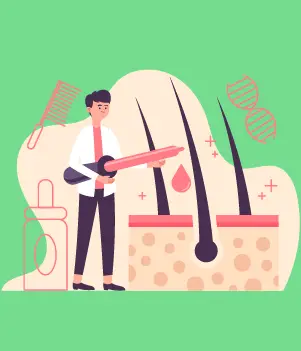
An iron deficiency, otherwise known as ‘anemia’, is another common cause of hair loss and thinning.
In fact, an iron deficiency is the most common problem associated with hair loss in women.
If you feel as though an iron deficiency may be responsible for your hair loss, it’s a good idea to book a visit to your doctor and ask them to do a blood test.
This will determine if you are anemic. Luckily, fixing an iron deficiency is something that can be done simply by taking an iron supplement or eating iron-rich foods.
Signs Of Losing Your Hair
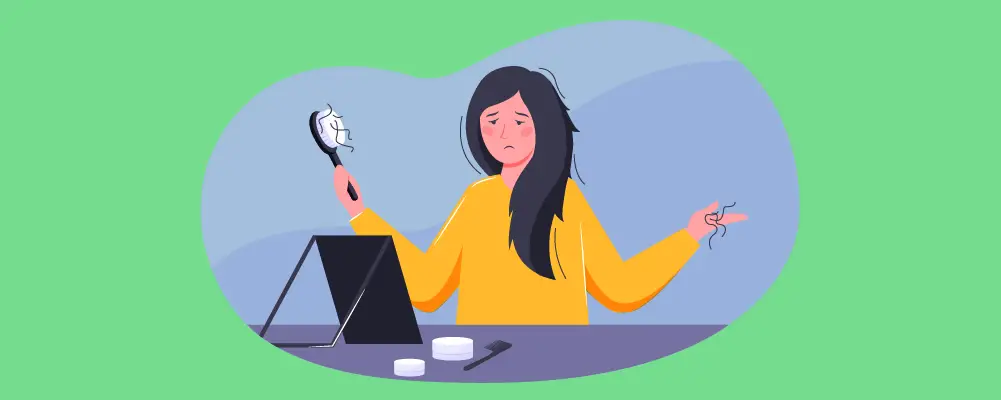
We’ve spoken briefly about how hair loss can happen in a variety of ways. But what are the signs of losing your hair?
Below, we’ll take a look at some of the most common signs of hair loss so that you can keep an eye out for them and start to rectify the problem before it’s too late.
Gradual Thinning On Top Of The Head
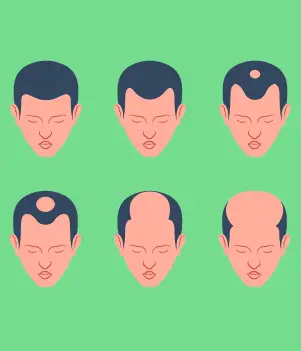
A gradual thinning of hair on top of the head is the most common sign of hair loss and it’s something that naturally occurs as we age.
The way the hair thins differs between men and women in the following ways:
- Men: Hair loss often begins receding at the hairline at the forehead.
- Women: Hair loss often occurs as a broadening of the hair’s natural parting.
In older women, hair loss can also be seen in the form of a receding hairline, known as frontal fibrosing alopecia. The exposed skin may also look shiny or mildly scarred.
Sudden Loosening Of Hair
You may notice handfuls of hair coming from your head when brushing or washing your hair. In some cases, hair may even come loose if just given a gentle tug.
This is usually caused by emotional or physical shock and, although it can cause thinning all over the head, it’s usually a temporary issue.
This doesn’t mean that it’s not something to keep an eye on, though.
If you’ve noticed a sudden loosening on your hair for more than six months, it’s a good idea to visit your doctor. It may be the first stages of another type of hair loss or an underlying health condition.
Circular Or Patchy Bald Spots
Although less common than a gradual thinning of the hair from the hairline or parting, a lot of people begin to notice their hair loss takes the form of circular or patchy bald spots.
This most commonly occurs on the crown of the head, but it can also happen at sporadic intervals all over the head, as well as the beard and eyebrows.
You may also notice that your skin becomes itchy or painful before these patchy bald spots occur.
Full-Body Hair Loss

Certain conditions, such as alopecia universalis, can cause full-body hair loss.
This usually starts as small, bald patches forming all over the body including the head, face, and pubic areas.
You may also experience a burning or itching sensation in certain areas followed by hair loss, but this is less common.
People undergoing radiotherapy or chemotherapy as a treatment for cancer may also experience full-body hair loss, but this is temporary and will usually grow back.
Patches Of Scaling That Spread Over The Scalp
If you’ve noticed patches of scaling spreading over your scalp, there’s a chance that you may have ringworm. This is highly possible if you’re also experiencing redness, swelling, or oozing from the scaling.
In this instance, the hair is not permanently lost and you can treat a ringworm infection by using a specially medicated shampoo. Once the infection has been treated, the hair will grow back as healthy as it did before.
How To Prevent Hair Loss Tips
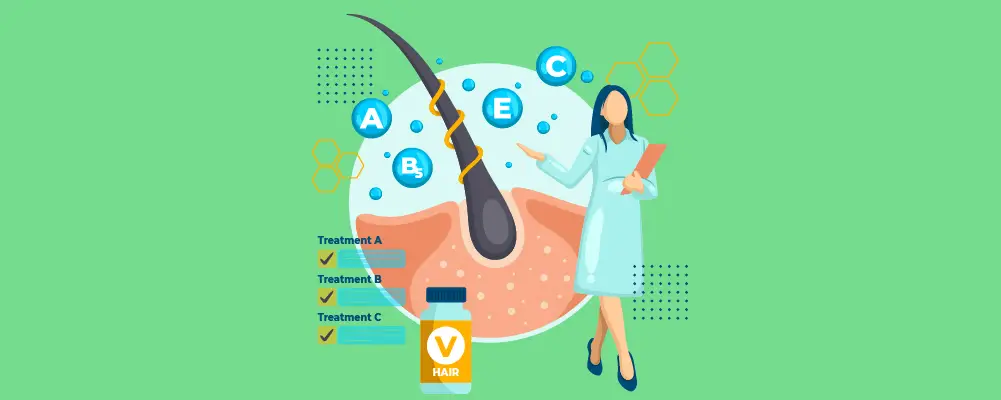
As with most health issues, prevention is usually the best cure when it comes to hair loss.
Even if you inherited a genetic trait that means your hair will start to thin, there are some things you can do to halt time a little and keep your hair looking thick and healthy for longer.
Below, we’ll take a look at some of the best tips for preventing hair loss. The majority of these are quite manageable too, so there’s no need to worry about going to any special lengths to prevent your hair from falling out.
Eat A Balanced Diet

We all know how important eating a balanced diet is for our overall health.
But did you know that eating foods that are packed with certain vitamins and minerals can also help prevent hair loss?
Zinc
Any food that has zinc in it is a great addition to your diet if you’re trying to prevent hair loss.
Zinc doesn’t only play a vital role in helping your major organs function, but it also has fantastic healing and immune-system boosting properties.
It helps to repair the lymphatic system to support tissue growth and, ultimately, helps hair grow strong and healthy. This makes it ideal for anybody suffering from androgenic alopecia.
Foods that are rich in zinc include spinach, beef, shrimp, garlic, and salmon. You can also take a zinc supplement to easily increase your zinc levels.
Protein

There isn’t a single organ in the body that doesn’t need some form of protein to function properly, but it’s also essential to keeping a healthy head of hair.
This is particularly true of a protein called ‘Keratinocytes’.
These are responsible for producing keratin, which is essential for healthy hair growth.
Not getting enough protein in your diet can lead to hair loss and create dull, brittle hair that is easy to damage. Luckily, getting protein into your diet is super easy. Go for foods such as chicken, eggs, salmon, tofu, quinoa, and red kidney beans.
Omega 3

Omega 3 fatty acids are a great addition to your diet and can help to prevent hair loss as they have anti-inflammatory properties that open the hair follicles.
In turn, this promotes strong, healthy growth.
If your diet doesn’t consist of enough Omega 3, the hairs that you naturally lose every day are not replaced and, as such, your hair begins to thin out.
If you want to get more Omega 3 into your diet to prevent this from happening, go for ingredients such as flaxseeds, walnuts, salmon, tuna, and kale.
Minimize Stress
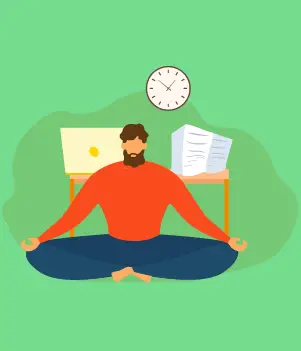
Whether you have a demanding job or you’ve undergone emotional or physical trauma, stress is one of the biggest causes of hair loss.
It’s also one of the main causes of alopecia areata.
To prevent hair loss during a stressful period, it’s important to try and minimize your stress levels as much as possible.
Below, we’ll take a look at some of the best ways to relax your mind and your body so that your cortisol levels are kept in check and the risk of losing your hair through stress is reduced.
- Emotional Support: Don’t be afraid to pick up the phone or visit a friend and tell them how you’re feeling. They’ll be happy to listen and you’ll find that sharing a load will help you feel more relaxed.
- Reevaluate Your Workplace: You don’t necessarily have to quit your job if it’s stressing you out, but you can take a moment to reevaluate how certain things are done. Workplace stressors include fellow employees, how you manage your workload, and specific responsibilities. If you’re finding an aspect of your job is starting to become a bit overwhelming, speak with your manager and see if anything can be done to help reduce your stress levels at work.
- Eat Healthier: We’ve gone into quite a lot of detail above how certain foods can help to prevent hair loss, but avoiding certain foods can also help to reduce your stress levels. Try and steer clear of processed sugar, caffeine, and alcohol. Too much of these will increase your stress levels, and some will even act as a depressant.
- Exercise Regularly: We’re all aware of the physical benefits of exercise, but working out regularly comes with mental benefits too. The endorphins that are released following exercise increase your energy levels and reduce your stress levels. You don’t necessarily have to run for miles, either. Find a sport or a type of exercise that you enjoy and use that as your stress relief. If you’re recovering from physical trauma, it’s worth checking with your doctor before you start a workout routine.
- Music: Using music as a form of stress relief is highly effective. You don’t need to specifically listen to whale songs or the sound of falling rain though! It’s all about what works for you. If you find that listening to your favorite rock band helps to reduce stress, turn the volume up and let the music take you to your happy place.
- Spend Time In Nature: Sometimes it’s the hustle and bustle of city life that sends our stress levels soaring. Try heading out into nature and spending some time enjoying the beautiful scenery and calming sounds. This is a great way to soothe your mind, reduce your stress levels and, ultimately, prevent hair loss through stress.
Minimize Drinking
You may not know that drinking on a regular basis also has an effect on the rate you’re losing your hair.
This is because drinking alcohol can affect your thyroid and other hormone interactions that are responsible for regulating hair growth and hair shedding.
Drinking alcohol too regularly can even lead to hyperthyroidism, and this causes hair loss and thinning across the entire scalp. This can happen over the course of a few months or years, depending on how much alcohol you’re drinking.
To prevent this from happening, it’s a good idea to keep alcohol consumption to a minimum. And, when you do drink, don’t overdo it.
A couple of glasses of wine once or twice a week is enough to satisfy your drinking urges while still being able to prevent hair loss.
It’s important to remember, also, that alcohol is a depressant. So, while you may find it helps to relieve your stress levels temporarily, drinking too much will do your mental health no favors in the long run.
Consider Medication
If all else fails, you can consider taking medication to help prevent hair loss. If you do decide to take this route, look for a hair loss product that contains Minoxidil.
This is an antihypertensive vasodilator that works by dilating the blood vessels in the scalp and improving the function of the hair follicles. New hair growth is promoted as a result.
It’s not a quick-fix solution, though. It can take up to four months to start seeing the results of a hair loss product that contains Minoxidil.
This is simply because it takes a while for the hair to grow back, so you’ll need to exercise some patience when using it.
If you do decide to start using Minoxidil to prevent hair loss, you should also keep in mind the rest of the advice we’ve outlined above.
Eating an unhealthy diet, not keeping your stress levels down, and drinking too much alcohol will practically render the Minoxidil useless.
It’s all about balance. Use the medication as instructed and follow a healthy lifestyle, and you’ll dramatically increase your chances of keeping a full head of hair.
Supplement Your Vitamin Intake
As well as eating a healthy diet that’s rich in zinc, protein, and omega 3, there are a few other vitamins that you can take to prevent hair loss.
You can either factor these into your diet through food, or you can use a vitamin supplement to make sure you’re getting enough of each of them every day.
Below, we’ll take a look at the five best vitamin supplements to prevent hair loss.
We’ll also go into what foods have naturally high levels of each of them, so you’re able to get them into your diet regularly as well as boosting your levels using a vitamin supplement.
- Biotin: Otherwise known as Vitamin B7, Biotin is an essential vitamin for keeping your cells healthy. If your Biotin levels are too low, you can experience hair loss, skin rashes, and brittle nails. Foods naturally rich in Biotin include egg yolks, meat, and whole grains.
- Iron: We’ve spoken above about iron deficiency and hair loss, so we know how important it is to keep our iron levels up. However, since the highest levels of iron are found in meat-based foods, it can be difficult for a vegetarian or vegan to find it naturally, so a vitamin supplement may be the best option. Having said that, you can find iron in leafy green vegetables and legumes, but you’ll need to eat large quantities. So, try and incorporate these into your diet as often as you can and follow up with a daily iron supplement.
- Vitamin C: Vitamin C is extremely important for preventing hair loss as it helps the bacteria in your gut absorb iron. And, the more iron your system can absorb, the better your chances of preventing hair loss are. Citrus fruits, leafy greens, and peppers are all good sources of Vitamin C, and it can also be taken as a supplement.
- Vitamin D: Maintaining a good level of Vitamin D isn’t only good for your bones, it also helps to prevent hair loss too. This is because it stimulates the hair follicles and allows hair to regrow healthily. It also creates new hair follicles and prevents existing hair from falling out prematurely. A Vitamin D supplement can be taken every day to boost your levels, and it’s also present in foods such as milk and fatty fish.
- Zinc: We’ve also spoken previously about how important it is to incorporate zinc into your diet above, but if you really want to increase your zinc levels it’s a good idea to use a zinc supplement. Naturally zinc-rich foods include shellfish, meat, beans, nuts, and seeds.
Exercise Regularly
We know that exercising regularly can reduce our stress levels and prevent issues such as alopecia areata from developing. But did you also know that exercising regularly is as good for our hairline as it is for our body?
Regular exercise boosts the circulatory system and ensures that blood is able to flow healthily through each vessel. In turn, this leads to healthy hair follicles and, ultimately, allows hair to grow healthily.
When hair follicles don’t receive enough oxygen, nutrients, and minerals that are carried to them through the blood, they can die and this is where hair loss occurs.
Find a sport or a workout routine that you enjoy and that you can fit into your lifestyle, and try to exercise for one hour, five days a week. This will keep blood circulating around your body and feeding your hair follicles.
Don’t overdo it, though. Taking part in a workout routine that you know you won’t be able to handle may result in injury, so take it at your own pace.
It’s also important to protect your existing hair when you’re working out. Hair cuticles can suffer from sun damage from prolonged exposure to UVA and UVB rays, and this can result in dry, thinning hair.
With this in mind, if you’re a runner or take part in outdoor activities, it’s a good idea to apply sunscreen to your scalp. You can also find special spray-on sunscreens that can be used to protect the hair shaft.
Essential Oils
Essential oils have been used for centuries as a homeopathic cure for many things, and there are some that are particularly good for preventing hair loss.
Below, you’ll find a list of the best essential oils for preventing hair loss, along with details of why each of them is so good.
- Rosemary Oil: As well as being a great cure for dandruff, rosemary oil has anti-inflammatory properties that make it ideal for preventing hair loss. It also increases circulation to the hair follicles and promotes thicker, healthy-looking hair growth. One study even found that it was just as effective at reducing hair loss as Minoxidil.
- Pumpkin Seed Oil: This prevents hair loss and promotes regrowth by soothing the scalp and follicle inflammation, and decreasing the constriction of blood vessels. It’s also a great choice for women who are suffering from hair loss as a part of menopause, as it’s believed to block DHT (Dihydrotestosterone).
- Peppermint Oil: If you’ve ever used peppermint oil before, you’ll be familiar with the tingling sensation that comes after applying it. This sensation is the oil boosting your circulation to the surface of your skin, so it’s ideal for keeping your hair follicles healthy. Peppermint oil has also been found to increase the number of hair follicles, follicle depth, and overall hair growth.
- Lavender Oil: This essential oil contains compounds that ease inflammation and stimulate cell growth. Lavender oil has also been found to increase the number of hair follicles and thicken the hair shaft.
- Clary Sage Oil: Similarly to lavender oil, clary sage oil contains a chemical compound (linalyl acetate) that increases the rate of hair growth. It also ensures that the hair grows back stronger, so it’s much more difficult to break.
- Cedarwood Oil: Contains antiseptic, anti-inflammatory, and anti-fungal properties. This makes it ideal for soothing an inflamed scalp and fighting bacterial build-up, which stops the follicles from getting damaged and allows hair to regrow normally. It’s also been noted that massaging the scalp daily with cedarwood oil showed significant improvement in hair growth for people suffering from alopecia areata.
- Tea Tree Oil: When used topically, tea tree oil can help to unclog and stimulate the hair follicles. This increases the rate of hair growth and allows the emerging hairs to grow as healthily as possible. It’s also good for cleaning the scalp and preventing bacterial build-up.
- Thyme Oil: This also has antibacterial and antimicrobial properties, so it’s a good alternative to tea tree oil (which can be quite concentrated) to clean the scalp and unclog hair follicles. Thyme oil can also be used to help hair regrowth for people that are suffering from alopecia.
Hair Care
The way you style and wear your hair is another thing you need to consider in your fight against hair loss. Certain styles pull on the follicle and loosen the hair, and certain styling equipment can cause damage to the hair.
In this section, we’ll take a look at hair care and discuss some ways to prevent hair loss when you’re maintaining and styling your hair.
Avoid Hair Tools With High Heat
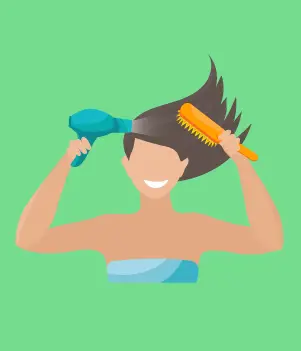
Straightening, curling, and styling your hair with heated tools can cause damage to the hair shaft and, in some cases, this can lead to it breaking.
Too much damage and you’ll soon notice that your hair looks as though it’s thinning.
Not to mention, it will feel dry and brittle to the touch.
To stop this from happening, it’s a good idea to avoid using hair tools with high heat.
This includes curling irons, straightening tools, and hairdryers.
Instead, try using spiral curlers or choose a styling product that enhances the natural shape of your hair without relying on heat.
Don’t Have A Hairstyle That Pulls On The Hairline
Certain hairstyles pull on the hairline and this can result in traction alopecia. This is most commonly caused by wearing tight ponytails, pigtails, and braids.
Luckily, there is a simple fix to this issue; simply don’t wear a hairstyle that pulls on the hairline.
If you need to keep your hair out of your face throughout the day and would usually rely on a tight ponytail to do this, try switching to a headband instead.
If you need to keep your hair braided, make sure that it’s a fairly loose braid so that your hair isn’t pulling on the follicle.
You also need to make sure that you free your hair from its restrictive hold as soon as possible. The less amount of time that your hair is pulled back tightly, the less of a risk there is of developing traction alopecia and losing your hair.
Don’t Wash Your Hair Too Little Or Too Often
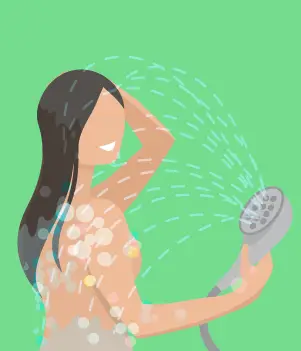
Daily shampooing can lead to hair loss as the chemicals in shampoo can make the hair brittle and easy-to-break.
With this in mind, it’s important that you’re not washing your hair too regularly.
Twice a week is ideal for cleaning the scalp, unclogging hair follicles, and allowing hair to grow healthily.
Conversely, it’s also important to make sure that you don’t go for too long without washing your hair.
If you do, then your hair follicles will become clogged with bacteria which can prevent hair from regrowing and could even lead to a bacterial infection.
Be sure not to scrub too hard at your scalp when you’re washing your hair either, as this will dislodge any hair that is already loosening. A firm but gentle pressure is ideal, working in a circular motion to loosen dirt and oil.
Rinse your hair with lukewarm water to stop your scalp from becoming aggravated too, especially if you have patches of scaling.
Use Hair Products That Enhance Hair Growth
One good way to incorporate the prevention of hair loss into your hair care routine is to use products that enhance hair growth. Again, any hair product that contains Minoxidil is a great choice for this.
If you’d prefer to go down a different route with your hair products, there are several ways you can help enhance your hair growth using all-natural ingredients.
- Onion Juice: As long as you can get past the initial smell, onion juice is a great natural remedy for enhancing your hair growth. Massaging this into your scalp can increase blood circulation to the hair follicles and, in turn, this boosts hair regrowth.
- Castor Oil: This contains minerals and omega acids that help to keep the scalp moisturized and prevent infection.
- Lemon Juice: Packed full of Vitamin C, lemon juice is good for balancing the pH of the scalp and promoting healthy hair regrowth.
Avoid Those With Chemicals

Anybody suffering from any form of hair loss should avoid using hair products that contain chemicals.
However, with so many ingredients to search through, determining what chemicals should be avoided can be quite difficult.
So, to make it easier, we’ve put together a list of the worst offenders.
Each of the chemicals listed below should be avoided if you’re suffering from hair loss, and we’ll also explain why.
- Ammonia: Any hair care product that contains ammonia should be avoided as it can cause existing hair to break and, in some cases, it can even make it fall out from the root.
- Hydrogen Peroxide: This is one of the most common ingredients in hair dye and as it penetrates and changes the color of your hair, it simultaneously dries it out. This leaves it brittle and damaged, and much more likely to break. It can also be extremely painful when applied to a sensitive scalp.
- Metallic Salts: This is another ingredient that you’ll find in hair dyes and perm solutions. As with hydrogen peroxide, it dries the hair out and can create damage and breakages to your hair.
- Sodium Hydroxide: Also known as ‘lye’ or ‘caustic soda’, sodium hydroxide is the same chemical you’ll find in drain cleaner! It’s found its way into hair care products such as relaxers and, perhaps unsurprisingly, it causes significant damage and scalp inflammation.
- Thioglycolic Acid: This is also found in relaxers and perm solutions, and it can cause your hair to break off from the scalp.
One troublesome ingredient to also look out for is alcohol, and it takes a little more explaining than some of the chemicals listed above.
Many hair care products contain alcohol and, for the most part, it should be avoided as it can create dryness and breakage.
This is especially true if the alcohol used to create the product is ‘Ethanol’, ‘SD Alcohol’, ‘Isopropyl Alcohol’, or ‘Isobutane Alcohol’.
However, there are actually some alcohols that are good for your hair, as they help ensure the cuticle lies flat and this helps your hair to regrow smoother and softer.
The good alcohols are ‘Stearyl Alcohol’, ‘Cetyl Alcohol’, and ‘Lauryl Alcohol’.
Conclusion
The first signs of losing your hair don’t necessarily have to mean saying goodbye to your hair as you once knew it. Instead, it can be seen as an opportunity to make some changes to your diet, lifestyle, and self-care routine.
By spending some time looking after yourself, you’ll notice that your thinning hair is soon starting to look full and healthy again.
You also don’t have to rely on strong chemicals or cosmetic surgery to prevent your hair from falling out.
As we’ve detailed throughout this article, there are loads of different methods to stop hair loss in its tracks and, ultimately, help you regain your confidence.


